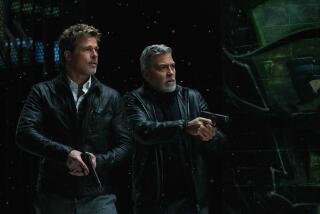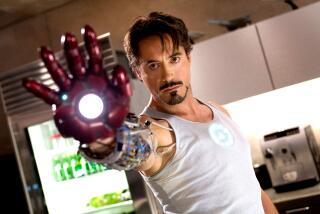Sherlock Holmes cookin’
- Share via
Any die-hard Sherlockian will tell you: Sure, Sherlock Holmes is quick to uncover clues and unmask subterfuge, even stand up to overwhelming evil. But when push comes to shove, he also can be counted on to bust out with some mucho macho action-hero moves.
Those in search of proof need look no further than the opening sequence of director Guy Ritchie’s movie reboot “Sherlock Holmes,” which opened Friday and has taken in an estimated $65.4 million at the box office. Producers for the $90-million action potboiler even came up with a pet name for the shooting style Ritchie used to capture the venerable Brit sleuth’s cerebral yet wince-inducing fisticuffs: “Holmes-o-vision.”
As Sir Arthur Conan Doyle’s crime-crushing Victorian gent, Robert Downey Jr. finds himself with nowhere to run during the movie’s curtain raiser, set inside a heavily fortified garrison. With a brawny guard closing in on him fast, Holmes uses his characteristic deductive reasoning to inventory his foe’s weak spots. Then the detective puts into play a combo of brawn and brains to punch the guard’s lights out.
“First point of attack, right ear,” Downey intones in voice-over. “Two, throat. Three, cracked ribs. In summary, neutralized.”
That kind of action has never explicitly appeared in any of Holmes’ movies or books before. And for anyone expecting to see the cape-wearing, tweed-clad Sherlock of yesteryear film fame, the implications should be elementary, as the old cliché goes. Basil Rathbone this newly rebranded Holmes most surely is not.
Turns out that bringing to life Sherlock version 7.0 -- a sharpshooting, bare-knuckle-brawling bohemian with a twitchy intellect, a louche lifestyle and a pronounced manic-depressive streak -- required a suspension of disbelief from almost everyone involved with the project. Studio executives and filmmakers had to look past certain initial prejudices in an effort to create what seems on track to be a new global movie franchise.
The project’s original writer Lionel Wigram, then a top production executive at Warner Bros., lobbied hard to get a new Holmes film off the ground for nearly a decade. In the end, he became an independent producer and finally sold his idea to the studio by commissioning an “Indiana Jones”-style graphic novel about the sleuth -- forefronting Holmes’ grittier existence as a martial arts champion, scenes that took place “off camera” or as asides in Doyle’s stories.
Producer Joel Silver went out on a limb to entrust British indie auteur Ritchie with his first big budget studio film after two splashy failures, “Revolver” and “Swept Away,” landed the director in professional purgatory for the better part of the ‘00s. (Ritchie’s 2008 crime thriller “RocknRolla,” also produced by Silver, managed to avoid losing money.)
“We took him out of movie jail,” said Silver. “ ‘RocknRolla’ made people realize he could do something splashier.”
And once the director, who’s best known in the tabloid world as Madonna’s ex, finally landed the most high-profile directing gig and biggest budget of his career, he initially rebuffed “Iron Man” star Downey’s overture to portray Holmes by telling the newly minted “opener” and two-time Oscar-nominee flat out: “You’re too old, mate.”
“I initially feared having an American actor,” Ritchie explained by phone from London, where he was cooking a dinner of goat cheese and caramelized onion tortellini, just days before the film’s United Kingdom-based publicity blitz. “I didn’t want to go headlong into a purely American extravaganza. Sherlock Holmes is an English icon. So I kept [Downey] at some distance until it dawned on me that Robert was the person to do it.”
Ritchie says he was only “taking the piss” out of Downey with that crack about his age. But the actor recalls the conversation differently. “I don’t think he was joking,” Downey said, suddenly serious.
Web of intrigue
In the film, Holmes and his right-hand man Dr. Watson (played by Jude Law and dubbed by wags in the British press as “the hot Watson” for his myriad dissimilarities to the harmless old duffer played by Nigel Bruce in the older films) are dragged into a web of intrigue after they bust up a ring masterminded by Lord Blackwood (Ritchie stalwart Mark Strong), an Aleister Crowley-like black magic figure engaged in the ritualistic killing of London virgins. Problem is, after being hanged for his crimes, it seems that Blackwood won’t stay in his grave.
As the fabric of civilized society unravels around Holmes, and his police and government counterparts begin to turn on him, it is left to Holmes and Watson to uncover what dark forces are afoot. Distinctly un-Holmesian street chases and punch-ups, shootouts and bare-torsoed boxing matches ensue.
For his part, Downey approached the Holmes portrayal more like his Oscar-nominated part in 1992’s “Chaplin” than his last big studio franchise, “Iron Man.”
“With Sherlock, I saw a great challenge that was more akin to embodying Charlie Chaplin than Tony Stark,” he said. “A lot of people believe that Sherlock was an actual living person. I took to doing it as if I was doing a biopic.”
Although some Sherlockians (as the Holmes equivalent of Trekkies are known domestically) have been vocal in denouncing the new movie for not strictly adhering to Doyle’s descriptions of the character, Leslie S. Klinger, editor of “The New Annotated Sherlock Holmes,” who also served as a technical advisor on the film, points out that there has not been one single “accurate” portrayal of the detective on the big screen to date.
“It’s new wine in old bottles,” Klinger said. “Sherlock has been filmed well over 200 times and everybody has always taken liberties with his stories. This particular film is an original story. But it’s respectful. It looks fantastic. And a lot of dialogue is lifted straight out of the stories.”
Likewise, despite whatever liberties “Sherlock Holmes” takes with Doyle’s creation (come on, did he really need to have rippling abs?), Jerry Kegley, president of the Curious Collectors of Baker Street, Los Angeles’ biggest Sherlock Holmes society, sees nothing but upside for the detective’s devoted fan base -- specifically the movie’s impact on the character’s continuing to be relevant for generations to come.
“Let’s face it, the Sherlockiana audience at large is middle-aged,” Kegley said. “If the whole Sherlockiana thing is going to go on, we need a younger audience. This is one way to get it.”
For his part, Ritchie said he felt gratified that the film had allowed him “to express where I was going creatively” -- as well as to do “period, intelligent and big.” But how does it feel to be sprung from movie jail?
“Anyone that’s been in this business has had ups and downs. Everyone surfs. You don’t think about it after a while. I can’t take any of it seriously,” Ritchie said, going on to paraphrase Kipling. “There’s a great line in a famous poem: ‘If you can recognize that triumph and disaster are the same impostor . . . you’ll be a man, my son.’ That’s how I feel.”
More to Read
Only good movies
Get the Indie Focus newsletter, Mark Olsen's weekly guide to the world of cinema.
You may occasionally receive promotional content from the Los Angeles Times.











